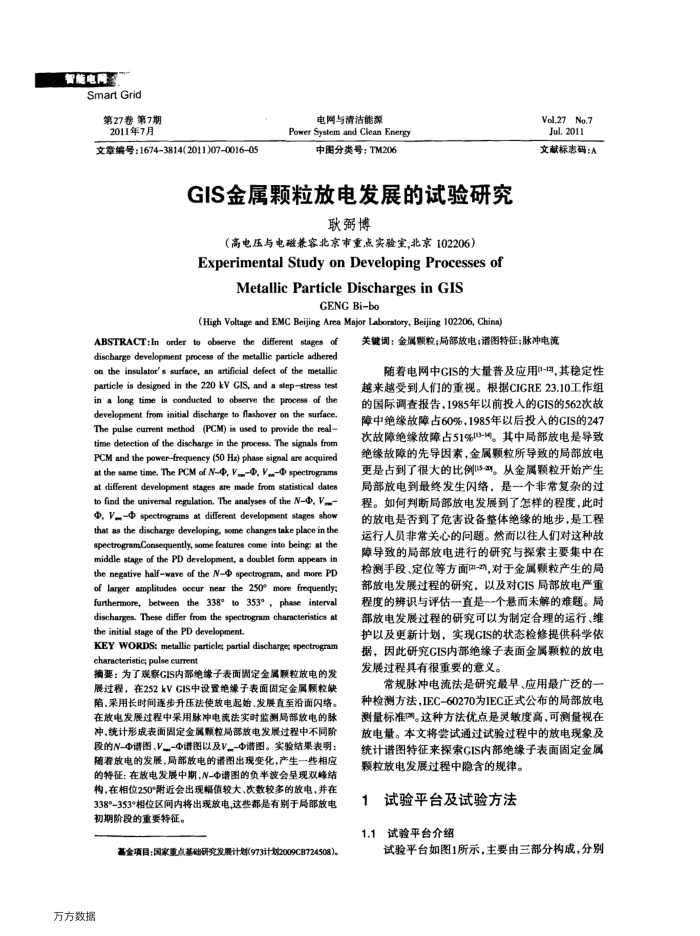您当前的位置:首页>论文资料>GIS金属颗粒放电发展的试验研究
内容简介
 智能电网
智能电网Smart Grid
第27卷第7期 2011年7月
文章编号:16743814(2011)07-001605
电网与清洁能源
Power System and Clean Energy
中图分类号:TM206
GIS金属颗粒放电发展的试验研究
联耿弼博
(高电压与电磁兼容北京市重点实验宝,北京102206)
Experimental Study on DevelopingProcesses of
Metallic ParticleDischarges inGIS
GENG Bibo
(High Voltage and EMC Beijing Area Major Laboratory, Beijing 102206, Chins)
ABSTRACT:ln order to observe the different stages of discharge development process of the metallic particle adhered on the insulator's surface, an artificial defeet of the metallic particle is designed in the 220 kV CIS, and a stepstress test in a long time is conducted to observe the process of the development from initial discharge to flashover on the surface. The pulse current method (PCM) is used to provide the real-time detection of the discharge in the process. The signals from PCM and the powerfrequency (50 Hs) phase signal are aoquired at the same time, The PCM of N, V_4, V spectrograms at different development stages are msde from statistical dates to find the universal regulation, The analyses of the NQ, V_ Q, V.Q spectrograms at different development stages show that as the discharge developing, some changes take place in the spectrogramConsequently, some features eome into being: at the middle stage of the PD development, a doublet form appears in the negative halfwave of the N spectrogram, and more PD of larger amplitudes oocur near the 250° more frequently: furthermore, between the 338° to 353°, phase interval discharges. These differ from the spectrogram chsracteristics at the initial stage of the PD development.
KEY WORDS: metallie particle; partial discharge spectrogram characteristie pulse eurent
摘要:为了观察CIS内部绝缘子表面固定金属颗粒放电的发展过程,在252kVGIS中设置绝缘子表面固定金属题较缺陷,采用长时间逐步升压法使故电起始、发展直至治面闪络。在放电发展过程中采用脉冲电流法实时监测局部放电的脉冲,统计形成表面固定金属颗粒局部放电发展过程中不同阶段的N-谱图、V_-Φ谱图以及V。-中谱图。实验结果表明随着放电的发展,局部放电的谱图出现变化,产生一些相应的特征:在放电发展中期,N-中谱图的负率波会呈现双峰结构,在相位250*附近会出现幅值较大、次数较多的放电,并在 338°-353°相位区间内将出现效电,这些都是有别于局部放电初期阶段的重要特征。
基金项目:国家重点基础研究发展计对(973计划2009CB724508)。
万方数据
Vol.27No.7 Jul.2011 文献标志码:A
关键调:金属题较;局部故电:谱图特征:脉冲电流
随着电网中GIS的大量普及应用-1,其稳定性越来越受到人们的重视。根据CIGRE23.10工作组的国际调查报告,1985年以前投入的GIS的562次故障中绝缘故障占60%,1985年以后投人的GIS的247 次故障绝缘故障占51%3-4。其中局部放电是导致绝缘故障的先导因素,金属题粒所导致的局部放电更是占到了很大的比例[15-。从金属颗粒开始产生局部放电到最终发生闪络,是一个非常复杂的过程。如何判断局部放电发展到了怎样的程度,此时的放电是否到了危害设备整体绝缘的地步,是工程运行人员非常关心的问题。然面以往人们对这种故障导致的局部放电进行的研究与操索主要集中在检测手段、定位等方面-2,对于金属颗粒产生的局部放电发展过程的研究,以及对CIS局部放电严重程度的辨识与评估一直是一个悬而未解的难题。局部放电发展过程的研究可以为制定合理的运行、维护以及更新计划,实现CIS的状态检修提供科学依据,因此研究GIS内部绝缘子表面金属颗粒的放电发展过程具有很重要的意义。
常规脉冲电流法是研究最早、应用最广泛的一种检测方法,IEC-60270为IEC正式公布的局部放电测量标准遇。这种方法优点是灵敏度高,可测量视在放电量。本文将尝试通过试验过程中的放电现象及统计谱图特征来探索GIS内部绝缘子表面固定金属赖粒放电发展过程中隐含的规律。
试验平台及试验方法
1.1
试验平台介绍
试验平台如图1所示,主要由三部分构成,分别
上一章:变电运行管理中危险点分析及控制策略研究
下一章:GPS对时功能在电力自动化中的应用